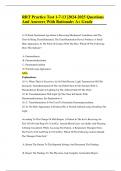Exam (elaborations)
RRT Practice Test 1-7-13 || 100 Questions And Answers With Rationale: A+ Grade
- Course
- Institution
RRT Practice Test 1-7-13 | Questions And Answers With Rationale: A+ Grade RRT Practice Test 1-7-13 | Questions And Answers With Rationale: A+ Grade
[Show more]



